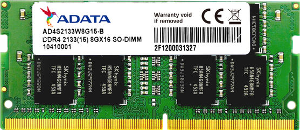DDR4





The DDR4 SDRAM, from 2014, is the successor to DDR3. DDR4 uses 288 pins instead of a 240 pins connection from DDR3. The SO-DIMM version has 260 connections.
The prefetch has not grown any larger than expected. The prefetch is therefore not doubled. However, larger bandwidths are achieved by sending more read/write commands per second.
The DDR4 has a significantly higher density of memory modules thanks to the Chip-Stacking-Technology, which allows up to 8 RAM modules to be placed on top of each other. In addition to the Dual-Channel DDR4, there is also the Quad-Channel technique, which in turn means a doubling of the Dual-Channel technology in data transfare.
DDR4 operates between 1.2 and 1.4 volts. The modules are supplied in 4GB to 64GB.
The operating speeds of the DDR4 SDRAM depend on the system bus speed on the motherboard. This can be read back at the bottom of a table. The table works as follows.
The DDR4-1600 has a memory clock rate of 200 MHz. This results in an I/O bus frequency of 800 MHz, which leads to a result of 1600 MT/s magatransferes per second. For a single memory module, the throughput is then 12.8 GB per second. Use of dual channel, the transition rate becomes 25.6 GB/s. With a set of 4 bars and using the Quad Channel, you arrive at 51.2 Giga Bytes per second.


